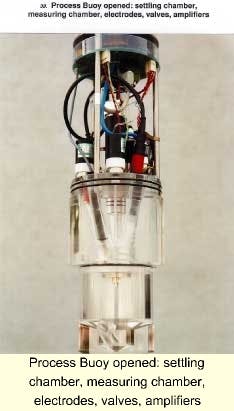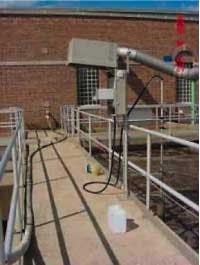Company Evaluates Ammonia Buoys for Nitrification Control
United Water staff working at wastewater treatment plants in Milwaukee wished, as part of their research and development efforts, to evaluate ammonia analyzers that would allow them to control more effectively the nitrification process in the treatment plants.
United Water manages the Milwaukee Metropolitan Sewerage District's two large wastewater treatment plants, the Milorganite biosolids fertilizer plant, the sewer interceptor and deep tunnel storage systems in addition to its 30-megawatt power plant. The company took over management and operations in January 1998 as part of a 10-year contract.
Combined, Milwaukee's Jones Island and South Shore facilities are handling 215 million gallons per day (MGD) and have capacities of 390 MGD and 300 MGD, respectively. The two wastewater treatment facilities serve 28 communities covering over 420 square miles both inside and outside of Milwaukee County.
Staff decided to evaluate the Isco/Stip model PBS1 Ammonia buoy to help control the nitrification process. The buoy was installed in an aeration basin to measure the ammonia removal at the Jones Island Wastewater Treatment Facility.
The process buoys measure ammonium or nitrate through direct immersion in aeration basins or final effluent. The buoy is filled by the hydrostatic pressure of the water and emptied by air pressure. The process computer, housed in a weatherproof enclosure, can support two buoys of either type.
In addition to controlling the chemical analysis and parameter measurement, the onboard computer with its graphical user interface handles the operational control of all maintenance and test routines. Multitasking capability allows simultaneous handling of special and routine operations. For example, the operator can recall and view or print the stored parameter charts and maintenance data of the last 14 days without interrupting the ongoing analysis and data acquisition. The built-in floppy disc drive allows storage of 90 days of data on a single diskette. Data can be imported into popular spreadsheet programs like Excel.
It generally is accepted that 30 percent to 40 percent of the cost of a conventional on-line cabinet-style wastewater analyzer could be directly related to piping and plumbing installation. These are costs above and beyond the actual equipment itself.
The design of the Isco-STIP Process Buoys eliminates the need for pumps in the wastewater as well as the need for on-line filtration devices. The package is designed for installation outdoors and can be installed within a few hours, which makes it suited to existing treatment plants. Valves within the buoy contact only air, reagents, and calibration standards, assuring a high level of reliability.
null
The buoy automatically calibrates itself daily using the standard addition method, and at the same time compensates for variability in the wastewater. Since the analyzer is installed outdoors insitu in the aeration basin, a more representative sample can be achieved avoiding the inherent delays associated with more traditional cabinet style monitors which require pumping, filtration and installation indoors.
In Milwaukee, samples were grabbed daily for comparison with the buoy's results. This data was used as part of the evaluation criteria to calculate a correlation factor to determine how well a continuous measuring device would trend with the laboratory results.
The samples were removed from the aeration basin just below the surface in close proximity to the process buoy.
According to Brice Cabibel of United Water, the Isco-STIP model PBS 1(Ammonium) Process Buoy was simple to maintain and installed within a matter of a few hours. Preventive maintenance consisted of a weekly cleaning of the settling chamber, analysis chamber and electrodes.
"Correlation with our laboratory results and grab samples showed a 98 percent correlation," Cabibel said. "No serious problems in operation were encountered during the 60 day evaluation.
"Based on this assessment and other online ammonia analyzers evaluated, United Water will feel comfortable recommending the Isco model PBS1 Ammonia buoy for future use," he added.


